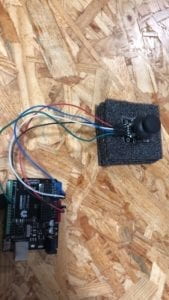Our U-Maze, is an interactive game that combines Arduino and Processing, user can control a digital ball to go through a maze, in the meantime unfold the under layer of the maze, which is a photo taken of the user at the beginning of the game. The concept of the game, was originally motivated by a mobile maze game, where player basically doing similar thing except there is no under layer, but the ball would left color on the road it has passed. The idea of adding the player’s photo was our own inspiration, since it would be really fun to add a part of taking photos at the beginning, both improves the interaction and gives our project a deeper meaning. The process of solving the maze, is in the meantime unfolding the figure of yourself, it’s like a process of self-recognition.
During the user-test session, our project as a prototype received some useful advice, for example the ball would possibly be overspread by the color of the background underlayer, bringing players difficulty in locating their positions. We made adaption to the project, as we changed the color mode of the ball, making it twinkling, changing its color among a ranges of cool colors. Another is that, Professor suggested us to make the phyical input of our project creative, rather than simply adopting joystick as an input to control the ball. We tried hard on that, as we tried to use a box, with the inner space being limited to a cross-road, where a real tiny ball can move from four directions by players leaning the box, with four pressure sensors at the end of each sides to detect in which direction the player hopes the ball to move. However, it turned out that the sensor was not sensitive enough to detect single hit, thus the design could not meet our expectation and unfortunately failed. We finally decided to use joystick as the input, it might be simple but it’s also quite visual and easy to get on hand.
Before our final presentation, we added several new changes to the project, including sound that guiding the player to take photos at the beginning and a click when the ball hit a wall. We also added several new maps so that everytime the game started, it could be a different challenge. Our project turned out to be very successful, our audience liked it very much and we felt happy and content.
Being in IMA and Interlab this semester was really a nice experience, as I’ve got in touch with new things, Arduino, Processing, etc. I’ve also known nice people, Professor Young, who’s really an earnest professor and is always ready to provide us help; Malika, my workmate, who gave me a lot of help and spent a lot of effots in making the project. Thanks to everyone that helps me this semester when I met difficulties.

